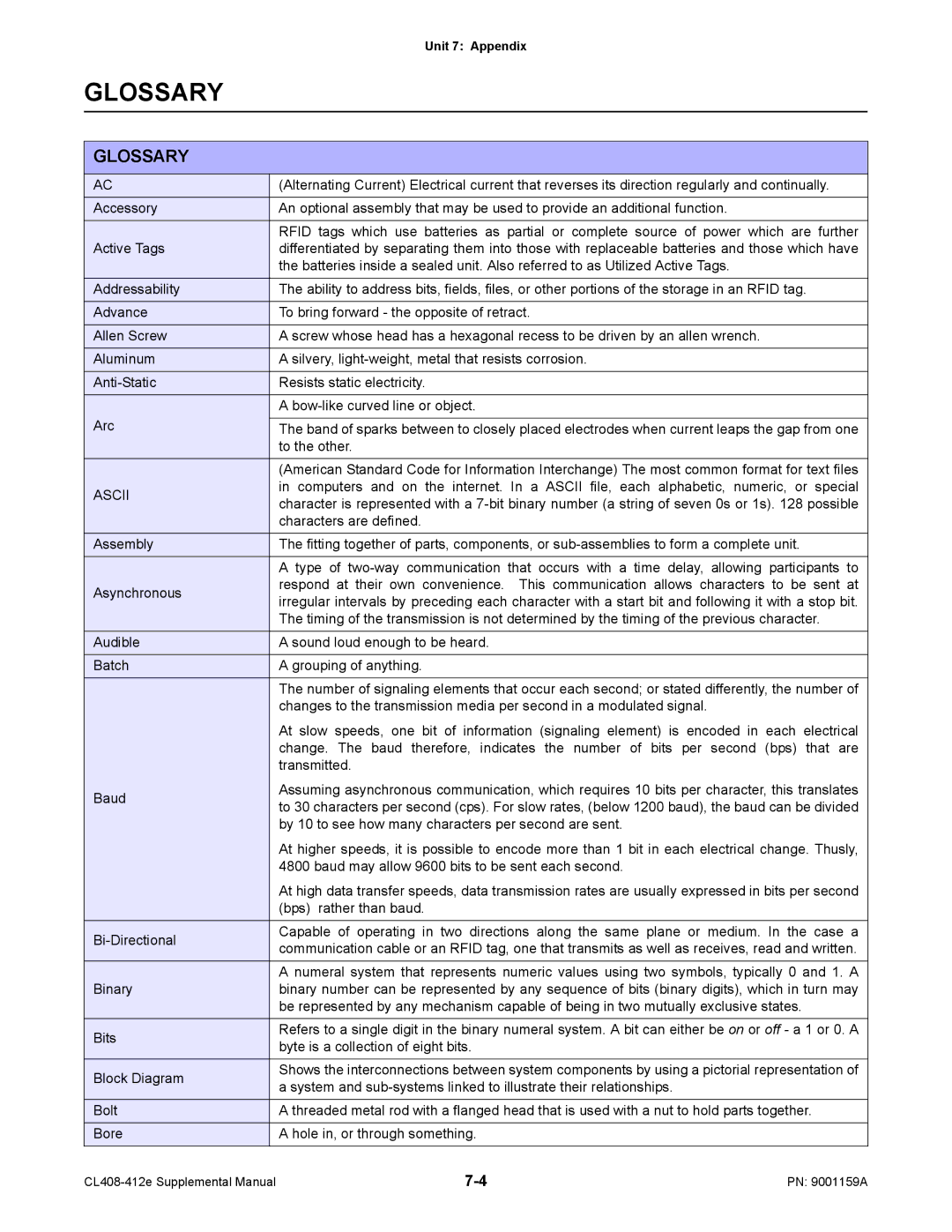| Unit 7: Appendix | |
GLOSSARY |
| |
|
| |
GLOSSARY |
| |
|
| |
AC | (Alternating Current) Electrical current that reverses its direction regularly and continually. | |
Accessory | An optional assembly that may be used to provide an additional function. | |
| RFID tags which use batteries as partial or complete source of power which are further | |
Active Tags | differentiated by separating them into those with replaceable batteries and those which have | |
| the batteries inside a sealed unit. Also referred to as Utilized Active Tags. | |
Addressability | The ability to address bits, fields, files, or other portions of the storage in an RFID tag. | |
Advance | To bring forward - the opposite of retract. | |
Allen Screw | A screw whose head has a hexagonal recess to be driven by an allen wrench. | |
Aluminum | A silvery, | |
Resists static electricity. | ||
| A | |
Arc |
| |
The band of sparks between to closely placed electrodes when current leaps the gap from one | ||
| to the other. | |
| (American Standard Code for Information Interchange) The most common format for text files | |
ASCII | in computers and on the internet. In a ASCII file, each alphabetic, numeric, or special | |
character is represented with a | ||
| ||
| characters are defined. | |
Assembly | The fitting together of parts, components, or | |
| A type of | |
Asynchronous | respond at their own convenience. This communication allows characters to be sent at | |
irregular intervals by preceding each character with a start bit and following it with a stop bit. | ||
| ||
| The timing of the transmission is not determined by the timing of the previous character. | |
Audible | A sound loud enough to be heard. | |
Batch | A grouping of anything. | |
| The number of signaling elements that occur each second; or stated differently, the number of | |
| changes to the transmission media per second in a modulated signal. | |
| At slow speeds, one bit of information (signaling element) is encoded in each electrical | |
| change. The baud therefore, indicates the number of bits per second (bps) that are | |
| transmitted. | |
Baud | Assuming asynchronous communication, which requires 10 bits per character, this translates | |
to 30 characters per second (cps). For slow rates, (below 1200 baud), the baud can be divided | ||
| ||
| by 10 to see how many characters per second are sent. | |
| At higher speeds, it is possible to encode more than 1 bit in each electrical change. Thusly, | |
| 4800 baud may allow 9600 bits to be sent each second. | |
| At high data transfer speeds, data transmission rates are usually expressed in bits per second | |
| (bps) rather than baud. | |
Capable of operating in two directions along the same plane or medium. In the case a | ||
communication cable or an RFID tag, one that transmits as well as receives, read and written. | ||
| ||
| A numeral system that represents numeric values using two symbols, typically 0 and 1. A | |
Binary | binary number can be represented by any sequence of bits (binary digits), which in turn may | |
| be represented by any mechanism capable of being in two mutually exclusive states. | |
Bits | Refers to a single digit in the binary numeral system. A bit can either be on or off - a 1 or 0. A | |
byte is a collection of eight bits. | ||
| ||
Block Diagram | Shows the interconnections between system components by using a pictorial representation of | |
a system and | ||
| ||
Bolt | A threaded metal rod with a flanged head that is used with a nut to hold parts together. | |
Bore | A hole in, or through something. | |
|
|
PN: 9001159A |
